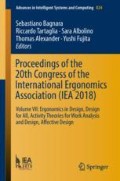Abstract
This article presents a research on emotions, which emerge from the interaction among user, urban furniture and its use setting. Three empirical studies aimed to: (i) identify and characterize emotional reactions (either positive or negative) raised from the interaction among users, urban furniture and public space; (ii) evaluate one positive emotion (pleasantness) and (iii) one negative emotion (fear) raised from the use of urban furniture/public space. Regardless of gender, the most mentioned positive emotion was pleasantness associated to safety. Fear was the main negative mentioned emotion, being a drawback in the use of public spaces. Attributes of eight constructs (users; activities performed in the public space; accessibility; privacy; urban furniture; vegetation; maintenance; buildings) were related to four space types (pleasant/safe; pleasant/unsafe; unpleasant/safe and pleasant/unsafe) resulting in basic elements to be used in guidelines for design and evaluation of emotional urban furniture/public space. Products with emotional appeal tend to be less vandalized, and to be more intensely used, therefore contributing to people’s well being and more livable cities.
Access this chapter
Tax calculation will be finalised at checkout
Purchases are for personal use only
References
Plutchnik R (1980) Emotion: psychoevolutionary synthesis. Harper and Row, New York
Ekman P (1992) An argument for basic emotions. Cogn Emot 6(3–4):169–200
Evans D (2001) Emotion: the science of sentiment. Oxford University Press, Oxford
Nasar JL (1997) The evaluative image of the city. Sage Publications, Thousand Oaks
Scott NA (1992) Chief student affairs officers: stressors and strategies. J Coll Stud Dev 33(2):108–116
Diener E (1984) Subjective well-being. Psychol Bull 92(2):410–433
Argyle M (1987) The psychology of happiness. Methuen, New York
Myers DG, Diener E (1995) Who is happy? Psychol Sci 6(1):10–19
Desmet P (2002) Designing emotions. Delft University of Technology, Delft
Jordan PW (2000) Designing pleasurable products: an introduction to the new human factors. Taylor and Francis, London
Norman D (2004) Emotional design: why do we love (or hate) everyday things. Basic Books, New York
Jordan PW (1998) Human factors for pleasure product use. Appl Ergon 28(1):25–33
Krippendorff K, Butter R (1984) Product semantics: exploring the symbolic qualities of form. Innov J Ind Des Soc Am 3(2):4–9
Krippendorff K (1989) On the essential contexts of artifacts or on the proposition that “design Is making sense (of things). Des Issues 5(2):9–39
Jacobs J (1992) Death and life of great American cities. Random House, New York
Marcus CC, Francis C (1990) People places: design guidelines for urban open spaces. Van Nostrand Reinhold, New York
Helander MG, Tham MP (2003) Hedonomic: affective human factors design. Ergonomics 46(13–14):1269–1272
Khalid HM, Helander MG (2006) Customer emotional needs in product design. Concur Eng Res Appl 14(3):197–206
Desmet PMA (2012) Faces of product pleasure: 25 positive emotions in human-product interactions. Int J Des 6(2):1–29
Pizzato GZ, Guimarães LBdM (2014) Design and emotion in collective public use products? In: 9th International Conference on Design & Emotion Proceeding. Bogotá, Colômbia, pp 250–255
Lynch K (1990) The image of the city. MIT Press, Cambridge
Bauman Z (2009) Confiança e medo na cidade. Zahar, Rio de Janeiro
Löbach B (2001) Design industrial: bases para a configuração dos produtos industriais. Edgard Blücher, São Paulo
Guimarães LBdM (2004) Funções do produto. In: Guimarães LBdM (ed.) Ergonomia de produto, vol 1. FEENGE, Porto Alegre
Pizzato, GZ, Guimarães LBdM, Caten C (2012) The perception of pleasantness in a product of collective use: the bus shelter. Work 41(Suppl 1):282–289
Pizzato GZ, Guimarães LBdM, Damo A (2012) The perception of fear when using urban furniture. Work 41(Suppl 1):266–271
Morris E (2009) The fundamentals of product design. Bloomsbury, Lausanne
Dazkir S, Read M (2012) Furniture forms and their influence on our emotional responses toward interior environments. Environ Behav 44(5):722–734
Loukaitou-Sideris A (2005) Is it safe to walk here? In: Transportation research board conference proceedings. Research on women’s issues in transportation. Transportation Research Board Conference, Transportation Research Board, Washington, D.C., vol 2, pp 102–112
Stamps AE (2000) Psychology and the aesthetics of the built environment. Kluwer Academic Publishers, Boston
Park SH, Kim JH, Choi YM, Seo HL (2013) Design elements to improve pleasantness, vitality, safety, and complexity of the pedestrian environment: evidence from a Korean neighborhood walking case study. Int J Urban Sci 17(1):142–160
Lang J (1994) Urban design: American experience. Van Nostrand Reinhold, New York
Gehl J (1987) Life between buildngs. Van Nostrand Reinhold, New York
Despard E (2012) Cultivating security: plants urban landscape. Space Cult 15(2):151–163
De Nisco A, Warnaby G (2014) Urban design and tenant variety influences on consumers’ emotions and approach behavior. J Bus Res 67(2):211–217
Mehta V (2007) Lively streets: determining environmental characteristics to support social behavior. J Plan Educ Res 27(2):165–187
Kuo F, Sullivan W (2001) Environment and crime in the inner city: does vegetation reduce crime? Environ Behav 33(3):343–367
Kaplan S, Kaplan R (1989) The experience of nature: a psychological perspective. Cambridge University Press, New York
Russel JA, Snodgrass J (1987) Emotion and the environment. In: Stokols D, Altman I (eds) Handbook of environmental psychology, vol 1. Wiley, New York, pp 245–280
Russel J (1988) Affective appraisals of environments. In: Nasar JL (ed) Environmental aesthetics: theory, research, and applications. Cambridge University Press, New York, pp 120–129
Author information
Authors and Affiliations
Corresponding author
Editor information
Editors and Affiliations
Rights and permissions
Copyright information
© 2019 Springer Nature Switzerland AG
About this paper
Cite this paper
Pizzato, G.Z., de Macedo Guimarães, L.B. (2019). Emotional Attributes of Urban Furniture. In: Bagnara, S., Tartaglia, R., Albolino, S., Alexander, T., Fujita, Y. (eds) Proceedings of the 20th Congress of the International Ergonomics Association (IEA 2018). IEA 2018. Advances in Intelligent Systems and Computing, vol 824. Springer, Cham. https://doi.org/10.1007/978-3-319-96071-5_218
Download citation
DOI: https://doi.org/10.1007/978-3-319-96071-5_218
Published:
Publisher Name: Springer, Cham
Print ISBN: 978-3-319-96070-8
Online ISBN: 978-3-319-96071-5
eBook Packages: Intelligent Technologies and RoboticsIntelligent Technologies and Robotics (R0)

